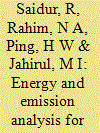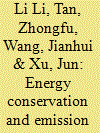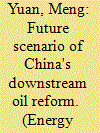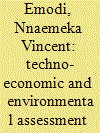|
|
|
Sort Order |
|
|
|
Items / Page
|
|
|
|
|
|
|
| Srl | Item |
| 1 |
ID:
111074


|
|
|
|
|
| Publication |
2012.
|
| Summary/Abstract |
The combination of a prime mover and an energy storage device for reduction of fuel consumption has successfully been used in automotive industry. The shipping industry has utilised this for conventional submarines. The potential of a load levelling strategy through use of a hybrid battery-diesel-electric propulsion system is investigated. The goal is to reduce exhaust gas emissions by reducing fuel oil consumption through consideration of a re-engineered ship propulsion system. This work is based on operational data for a shipping fleet containing all types of bulk carriers. The engine loading and the energy requirements are calculated, and sizing of suitable propulsion and the battery storage system are proposed. The changes in overall emissions are estimated and the potential for fuel savings identified. The efficiency of the system depends on the storage medium type, the availability of energy and the displacement characteristics of the examined vessels. These results for the global fleet indicate that savings depending on storage system, vessel condition and vessel type could be up to 0.32 million tonnes in NOx, 0.07 million tonnes in SOx and 4.1 million tonnes in CO2. These represent a maximum 14% of reduction in dry bulk sector and 1.8% of world's fleet emissions.
|
|
|
|
|
|
|
|
|
|
|
|
|
|
|
|
| 2 |
ID:
163550


|
|
|
|
|
| Summary/Abstract |
Municipal solid waste in China has increased rapidly in recent years with urbanization and economic development. The establishment of affordable, effective and truly sustainable waste management is a key point for the development of urban areas. However, as a renewable energy, the cost-benefit of supporting and the environmental performance for waste incineration power are seldom discussed. This paper discusses the current situation of waste incineration power industry in China and analyzes the required subsidies and emission reductions. The results show that waste incineration power needs relatively less financial support and perform well on emission reduction. Main obstacles to the development of waste incineration have also been investigated from the perspective of government, enterprises and local residents. Lastly, some suggestions are offered on how to tackle these issues. For instance: more regulation on waste classification; to integrate the informal workers into formal municipal waste management system; to communicate more effectively to the public to dispel general misunderstanding; application of the waste heat from cogeneration plants to local heat supply or central heat supply system.
|
|
|
|
|
|
|
|
|
|
|
|
|
|
|
|
| 3 |
ID:
090096


|
|
|
|
|
| Publication |
2009.
|
| Summary/Abstract |
The industrial sector is the largest user of energy in Malaysia. Industrial motors account for a major segment of total industrial energy use. Since motors are the principle energy users, different energy savings strategies have been applied to reduce their energy consumption and associated emissions released into the atmosphere. These strategies include using highly efficient motors, variable speed drive (VSD), and capacitor banks to improve the power factor. It has been estimated that there can be a total energy savings of 1765, 2703 and 3605 MWh by utilizing energy-efficient motors for 50%, 75% and 100% loads, respectively. It was also found that for different motor loads, an estimated US$115,936 US$173,019 and US$230,693 can be saved in anticipated energy costs. Similarly, it is hypothesized that a significant amount of energy can be saved using VSD and capacitor banks to reduce speed and improve the power factor, thus cutting energy costs. Moreover, a substantial reduction in the amount of emissions can be effected together with the associated energy savings for different energy savings strategies. In addition, the payback period for different energy savings strategies has been found to be reasonable in some cases.
|
|
|
|
|
|
|
|
|
|
|
|
|
|
|
|
| 4 |
ID:
105786


|
|
|
|
|
| Publication |
2011.
|
| Summary/Abstract |
Because of China's increasingly limited energy supplies and serious environmental pollution, much attention has been paid to conserving energy and reducing emissions to help the country's economy achieve sustainable development. As the electric power industry is the largest consumer of coal resources in China and also emits high levels of air pollutants each year, the Chinese government has enacted many technical and economic policies for energy conservation and emission reduction in the last few years. These policies are summarized in this paper, along with relevant laws and medium- and long-term plans, all of which address ideas such as adjusting the power generation mix, promoting demand-side management, introducing energy-efficient scheduling, and installing desulfurization units. The paper also assesses the results of these policies by analyzing several key indicators of energy consumption and emissions. The analysis shows that although some progress has been made in conserving energy and reducing emissions, substantial work is still required for China to catch up with developed countries. Some suggestions for future work are provided.
|
|
|
|
|
|
|
|
|
|
|
|
|
|
|
|
| 5 |
ID:
105724


|
|
|
|
|
| Publication |
2011.
|
| Summary/Abstract |
The small or middle coal mines with illegal operations in developing countries or regions can cause bad energy waste and environmental disruption. The project of coal-resource integration in Shanxi Province of China gives a new idea or an approach to energy saving and emission reduction. It is a social- and economic-ecological project. The paper shows the targets of energy saving and emission reduction in Shanxi Province, and analyses the aims, significance, design process and implementation of the integration project. Based on that, the paper discusses the challenges and opportunities the project brings. The analysis shows that the project of coal-resource integration in developing countries or regions can effectively improve mining technologies, collect capital and impel international cooperation and exchange. Finally, the paper analyses the concerns about the future, including the possible problems of implementation period, industrial updating, environmental impact and re-employment. However, the successful integration of coal resources can mitigate energy crisis and climate crisis and promote cleaner production effectively.
|
|
|
|
|
|
|
|
|
|
|
|
|
|
|
|
| 6 |
ID:
176766


|
|
|
|
|
| Summary/Abstract |
Improving energy supply efficiency and quality is regarded as a key pathway to shifting towards a fully sustainable energy system. To address the low efficiency and high emissions in the downstream oil industry caused by the problem of vertically integrated monopoly, the Chinese government is making an effort to promote a multiproduct pipeline network reform. The fundamental and indispensable step for this goal is the pipeline network interconnectivity. This paper quantifies the energy-environmental impacts of the pipeline network interconnectivity reform on China's downstream oil supply chain to 2030. An integrated framework is developed to obtain the detailed design-scale information required for assessment, introducing demand forecasting and demand reallocation into a pipeline network optimal planning model. The model is formulated as a fuzzy mixed integer linear programming that optimizes the infrastructure development scheme and supply chain operation plan simultaneously while taking into account demand uncertainty. The results show that, compared with the baseline, the pipeline interconnectivity reform could reduce yearly energy consumption and CO2 emissions by 9.7–19.8% and 12.5–17.9%, respectively. It is shown that this reform policy could overcome infrastructure constraints, increase pipeline utilization, and improve both energy and environmental performance. The proposed framework can be a theoretical guideline for policymakers within and beyond China.
|
|
|
|
|
|
|
|
|
|
|
|
|
|
|
|
| 7 |
ID:
105753


|
|
|
|
|
| Publication |
2011.
|
| Summary/Abstract |
On 19 May 2010, the European Union adopted a Directive stipulating that by the end of 2020, Member States must ensure that all newly constructed buildings consume 'nearly zero' energy. In Germany, drastic reductions of energy demand for space heating have already become a policy target over the last decade, both for new and existing dwellings. In this article, we evaluate the impact of past and future policies on the development of buildings with a very high energy performance (VHEP) and on their primary energy demand and emissions. These dwellings account for 4% of all dwellings which have been constructed since 2001 and 1% of the total building stock. We have defined different policy scenarios, all of which assume a gradual increase of requirements for new and existing buildings and a continuation of the support policies that stimulate both new constructions and ambitious refurbishments. In the most ambitious scenario, the proportion of VHEP dwellings will increase by up to 30% of the total stock in 2020 and the share of nearly zero and zero-energy dwellings will then make up 6%. This will lead to emission reductions of over 50% of the 1990 level and primary energy reductions of 25% compared with today.
|
|
|
|
|
|
|
|
|
|
|
|
|
|
|
|
| 8 |
ID:
088027


|
|
|
|
|
| Publication |
2009.
|
| Summary/Abstract |
One way to reduce greenhouse gas emissions from the transportation sector is to replace fossil fuels by biofuels. However, production of biofuels also generates greenhouse gas emissions. Energy and greenhouse gas balances of transportation biofuels suitable for large-scale production in Finland have been assessed in this paper. In addition, the use of raw materials in electricity and/or heat production has been considered. The overall auxiliary energy input per energy content of fuel in biofuel production was 3-5-fold compared to that of fossil fuels. The results indicated that greenhouse gas emissions from the production and use of barley-based ethanol or biodiesel from turnip rape are very probably higher compared to fossil fuels. Second generation biofuels produced using forestry residues or reed canary grass as raw materials seem to be more favourable in reducing greenhouse gas emissions. However, the use of raw materials in electricity and/or heat production is even more favourable. Significant uncertainties are involved in the results mainly due to the uncertainty of N2O emissions from fertilisation and emissions from the production of the electricity consumed or replaced.
|
|
|
|
|
|
|
|
|
|
|
|
|
|
|
|
| 9 |
ID:
132673


|
|
|
|
|
| Publication |
2014.
|
| Summary/Abstract |
Over the past three decades, people×s living standard in China has been greatly improved, accompanied by the rapid increasing building energy consumption. Rural building energy consumption has become one of the most important parts of the total energy consumption in China, which deserves to be paid much attention. It is of vital importance to promote building energy efficiency for the New Socialist Countryside and energy conservation and emission reduction. This paper provides an overview of building energy consumption in the countryside, which figures out the situation and challenges in energy-saving work. The government has worked for years on rural building code system aimed at narrowing the energy gap between urban areas, but it is in the beginning phase. This paper has analyzed the only special issues about rural building energy efficiency and the mandatory standards for urban buildings, which can facilitate the development of rural building energy efficiency. Based on the above analysis, some recommendations regarding the improvement of rural building energy efficiency are given.
|
|
|
|
|
|
|
|
|
|
|
|
|
|
|
|
| 10 |
ID:
117940


|
|
|
|
|
| Publication |
2013.
|
| Summary/Abstract |
Understanding the impact ofregime complexes on global governance calls
for creative policy thinking. This introduction provides a new and more
precise definition of the concept of regime complex. It also suggests specific tools to characterize regime complexes and analyze their impacts on
global governance. The articles in this issue deepen the analytical understanding of complexes by examining concrete examplesin various domains
of global governance such as piracy, taxation, energy, food security, emissions reduction, carbon sinks, biosafety, and refugee governance. In addition to providing an in-depth description of a variety of different regime
complexes, this issue is innovative on three accounts: (1) it presents complexes as both barriers and opportunities for global governance and gives
explanations for these diverse outcomes; (2) it shows how a broad spectrum of actors is necessary for understanding the creation and evolution
of complexes; and (3)it qualifiesformer claimsto the effectthat only powerful actors can impact regime complexes. institutional density.
|
|
|
|
|
|
|
|
|
|
|
|
|
|
|
|
| 11 |
ID:
116908


|
|
|
|
|
| Publication |
2012.
|
| Summary/Abstract |
China is the largest energy consumer and CO2 emitter in the world. The Chinese government faces growing challenges of ensuring energy security and reducing greenhouse gas emissions. To address these two issues, the Chinese government has announced two ambitious domestic indicative autonomous mitigation targets for 2020: increasing the ratio of non-fossil energy to 15% and reducing carbon dioxide emissions per unit of GDP by 40-45% from 2005 levels. To explore the role of non-fossil energy in achieving these two targets, this paper first provides an overview of current status of non-fossil energy development in China; then gives a brief review of GDP and primary energy consumption; next assesses in detail the role of the non-fossil energy in 2020, including the installed capacity and electricity generation of non-fossil energy sources, the share and role of non-fossil energy in the electricity structure, emissions reduction resulting from the shift to non-fossil energy, and challenges for accomplishing the mitigation targets in 2020; finally, conclusions and policy measures for non-fossil energy development are proposed.
|
|
|
|
|
|
|
|
|
|
|
|
|
|
|
|
| 12 |
ID:
166395


|
|
|
|
|
| Summary/Abstract |
This paper examines the impact of climate variability and change (CV&C), and energy policies on the future energy system in Australia. Scenarios were developed to represent CV&C impacts and policy options, which were analysed with the Long-range Energy Alternative and Planning system for the period 2010–2050. The results indicate that although energy demand is likely to increase threefold in the business-as-usual scenario, CV&C further increases demand to 150 petajoule. A combined policy option involving modal shift and penetration of electric and hydrogen fuel cell vehicles results in a 49–53% decrease in transport fuel demand and emissions. The economic analysis reveals a substantial decline in sales revenue and increase in generation costs due to CV&C impacts. Higher renewable energy integration results in lower wholesale electricity prices across independent electricity markets. Cumulative cost-benefit analysis indicates that economic benefits increase to US$4.9 trillion in an advanced renewable energy scenario. Emissions and energy consumed increased under climatic conditions, but decreased after policy intervention. Ignoring the influence of CV&C may result in underestimation of future energy demand and installed capacity in Australia. Therefore, energy and climate policies should consider long-term economic benefits over short-term system costs.
|
|
|
|
|
|
|
|
|
|
|
|
|
|
|
|
| 13 |
ID:
192779


|
|
|
|
|
| Summary/Abstract |
Human activities, such as burning fossil fuels for electricity generation, heating, and transport, are the primary drivers of a large amount of greenhouse gases emission. The individual consumers, able to influence the supply-chains behind the commodities their chose to fulfil their needs is the driver behind production and, consequently, its impacts. Thus, the active and willing participation of citizens in combatting climate change may be pivotal to address this issue. The present work is aimed at presenting and modelling a novel market-based carbon emission reduction mechanism, called BitCO2, designed to incentivize individual consumption choices toward lower carbon footprints. This mechanism is tested for the Italian private transportation sector thanks to an ad hoc developed System Dynamics model. The Battery Electric Vehicle (BEV) adoption, if compared with the Internal Combustion Engine Vehicle (ICEV) one, cause less CO2 emissions per km travelled. After a certain number of travelled km, a BitCO2 token is assigned to BEV owners for each ton of avoided CO2. This token can be exchanged in a dedicated market and used to get a discount on insurance services. Assuming a Social Cost of Carbon of 9.22 [2.13–22.3] €/tonCO2eq, model results show that the BitCO2 mechanism would allow for a cumulated CO2 emission reduction of 973 [68.9–5’230] ktonCO2eq over 20 years of operation with a peak of 39.3 [5.34–189] thousand additional BEV registration per year.
|
|
|
|
|
|
|
|
|
|
|
|
|
|
|
|
| 14 |
ID:
150680


|
|
|
|
|
| Summary/Abstract |
The European Commission discusses the change of free allocation plans to guarantee a stable market equilibrium. Selling over-allocated contracts effectively depreciates prices and negates the effect intended by the regulator to establish a stable price mechanism for CO2 assets. Our paper investigates mispricing and allocation issues by quantitatively analyzing variance risk premia of CO2 markets over the course of changing regimes (Phase I-III) for three different assets (European Union Allowances, Certified Emissions Reductions and European Reduction Units). The research paper gives recommendations to regulatory bodies in order to most effectively cap the overall carbon dioxide emissions.
|
|
|
|
|
|
|
|
|
|
|
|
|
|
|
|
|
|
|
|
|